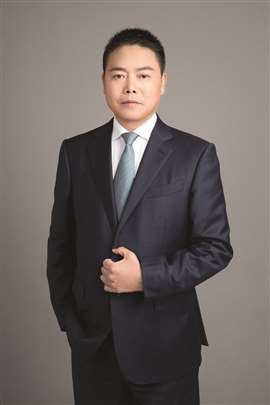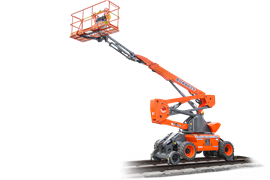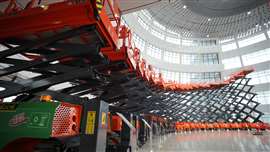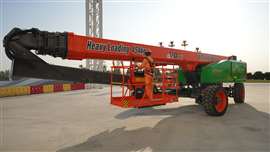Interview: Dingli owner reveals vision for the access sector
19 December 2023
AI spoke exclusively to Dingli owner Xu Shugen during a tour of the company’s expansive China-based facilities and learned of its vision for the MEWP sector and the company’s place in it.
 Xu Shugen, chairman at Dingli. (Photo: Dingli)
Xu Shugen, chairman at Dingli. (Photo: Dingli)
Dingli has positioned itself as a premium brand in the access market, following a string of partial acquisitions and long-term plans under which the company has rejected low pricing and global production in favor of innovation and remaining at a single base in its home country of China.
While Dingli’s manufacturing remains at home, the development of its technology has been aided by the investment in shares of three leading manufacturers, namely Italy-based telehandler specialist Magni, German spider lift producer Teupen, and US-based manufacturer MEC.
The resultant Dingli R&D centers have been responsible for the development of Dingli’s unique boom lift design, alongside the development of its large telescopic boom range.
Additionally, the company has set up major distribution partnerships with Magni and MEC for the European and US markets, and has just taken a further stake in MEC, bringing its share in the company up to 100%.
Meanwhile, Dingli has sold its 20% stake back to Magni Telescopic Handlers. Magni paid €61.4 million to return to 100% ownership, having sold the stake to Dingli for €14.4 million in early 2016.
Xu Shugen, the owner of Dingli, told AI during a tour of the company’s cutting edge facility in Zhejiang, the plan to buy into existing manufacturers to enhance R&D has been rooted in Dingli’s initial international strategy - to grow in the mature Asian markets of South Korea, Singapore and Japan, which demanded high-quality products.
Global business strategy
These ambitions have now spread globally, which has seen the company adopting an ambitious product strategy based on the principle of offering similarly priced equipment across mature and emerging markets.
Speaking through an interpreter, Mr. Xu explains, “At a very early stage we decided to sell our products to overseas countries in Asia, Europe and Americas and that’s why we had the strategy of acquiring a shareholding of the other foreign companies.”
The modular design of the company’s range, ensures 90% common components in each product series, is key to the strategy, combined with the principle of offering electric, hybrid and diesel options across its rough-terrain scissor and boom lift lines, up to the largest 44m working height BT44ERT telescopic boom lift.
Then, there is the fast expansion of the factory, and with phase 5 now completed, the facility covers a 250,000 square meters, with a high level of automation, including welding and bending lines that were designed in-house.
It means a typical boom lift can already be off-line in 30 minutes and a small scissor in less than seven minutes (the whole chain is completed in the factory).
All products, including large equipment up to 44m with telescopic boom can fit in a standard container, which is another key element of the company’s plans to manufacture in one spot and ship all items from there.
Combined, says Mr. Xu, the facilities suffice to ensure the manufacturer will never need to build factories in other parts of the world, such as Mexico - the location of choice for a number of new factories from other MEWP manufacturers with their focus on the Nort American market.
 Dingli overs a range of niche access equipment, including rail mounted units. (PHOTO: Dingli)
Dingli overs a range of niche access equipment, including rail mounted units. (PHOTO: Dingli)
The thinking behind Dingli’s approach to R&D is that every component is designed with all others in mind. The modular approach starts in the design department.
“Unlike other research departments that might develop parts separately - where A will develop one kind, B will develop another kind and C will develop a third, but they are not integrated, all our designs are integrated very closely and communicated. We will make adjustments based on customer needs.”
Targeting developing markets
Dingli’s approach also takes into consideration the requirements of developing access markets. “Rather than only considering developed markets we will gather information from different parts of the world and have a global strategy.”
This is supported by the international R&D centers in Italy, Germany and United States.
“We use this different kind of strategy to gather information from different places in the world unlike some companies that may restrict research to the mature access countries. This is how we develop our global concept.”
“Because we have the modular design and the quality of the parts is the same, we use the same models for emerging and high-end markets.
“To make new equipment attractive in emerging markets, rather than them choosing used machines, the terms of sale are different. The warranty and the value-added service might be different; for example, in a developed market a warranty might be three years and in an emerging market it might just be one year.”
On the subject of R&D and distribution, Mr. Xu is asked if there are plans to buy into any further companies. The answer is clear - “We are not going to expand with any more R&D centers because from our experience the three bases we have are enough to develop what the market requires and the good results have shown that.”
Indeed, from January to September this year, Dingli’s revenue grew by 13.77 % and net profit by 44.58 % - a significant rise on last year, which saw it become on the world’s three largest access equipment manufacturers.
Alternate power and oil-free machines
Multiple power options are a significant element of Dingli’s product offering. Apart from the advance in its RT scissor and boom ranges, which will see the creation of a complete line of T series articulating booms to match the electric, hybrid and diesel option of the telescopic line up to 44m, there has also been a focus on the Oil Free series of scissor lifts, which offer direct electric drive and no hydraulics.
 The full scissor line up in Dingli’s display room at its factory. (PHOTO: Dingli)
The full scissor line up in Dingli’s display room at its factory. (PHOTO: Dingli)
Oil-free all-electric products are available up to 16m working height and incorporate electric actuators on the scissor stack, replacing the hydraulics.
For units above 10m working height, the scissors require two actuators working in tandem, which Mr. Xu says is a major technological achievement and one that will be difficult to expand on.
“The technology is already very advanced. It may be possible to increase the height of the scissors slightly using this technology,” says Mr. Xu, “but it won’t allow it to be extended beyond that into rough terrains or boom lifts.”
The strains caused by the anti-dumping tariffs in the US, imposed on MEWPs produced in China, are well known and have led to Mexico becoming the location of choice for manufacturers to sidestep the tariffs, while others traditionally located in North America look for a less expensive alternative to manufacturing in the United States and Canada.
As mentioned, Dingli has no plans to follow suit, despite ongoing investigations by the European Commission and the UK Trade Remedies Authority into claims from western suppliers that ‘unusual commercial practices’ have emerged which are harmful to healthy and fair competition.
Manufacturing in Mexico vs China
Mr. Xu estimates that manufacturing in Mexico, or anywhere else for that matter, would increase the cost of Dingli’s production by 20%, compared to that at its home-based facilities. “We do don’t need another manufacturing site, as the manufacturing efficiency we have here [in China] cannot be replicated in Mexico.”
“With such a large product line it would not be easy to realize. We have over 250 specifications of our products, and if we set up in Mexico and it would be very difficult to decide which ones we should chose to produce there.”
Dingli is less affected than others by the tariffs in the US following a court case in the country in which Dingli demonstrated that it had not disproportionately lowered its prices in the market.
Dingli’s victory in the court case now means there is a 43% tariff on the goods it imports into the US, which is much less than tariffs imposed on other manufacturers, which can reach above 200%.
Another issue in the US is the risks around copying equipment. “If a manufacturer copies another they will likely be sued but our product does not.”
Ultimately, what does Mr. Xu believe will be the end result of the tariffs in the US? In typical fashion, Mr Xu is bullish about the gains he believes Dingli will make as a result of the situation.
“We will be the winners.” Mr Xu adds, “We will benefit a lot as we have our own quality and best product to win.”
China’s domestic market
The well-documented competition in the Chinese market has caused rental rates to drop significantly, and they are around 30% lower than they were just a couple of years ago.
 The 44 m working height BT44ERT. (PHOTO: Dingli)
The 44 m working height BT44ERT. (PHOTO: Dingli)
The big difference between mature access countries and developing ones is that the rental sector is more stable, says Mr. Xu.
“In new markets, some rental companies, particularly the many smaller ones, are not very clear about their strategies - they do not wholly understand the rental concept. For example, they may think that if they buy a machine, they can rent it for 10 years.”
The lower price concept that is seen particularly in growing markets like China is not a sustainable one, says Mr. Xu, even if it proves popular in the short term.
“Ultimately, it will not prove advantageous to any of the parties involved. In the end, the customer will not be happy.
Mr. Xu expands on the point. “Because you are not just providing a low price to one customer, you are giving a low price to the others.
“If you are the only rental company getting this low price, then you will be happy, as you will have the benefit and the profit, but when the manufacturer provides a low price to many rental companies, the problem is that the competition is still there.”
Mr. Xu adds, “It is a kind of suicide sales concept.”
Another problem says Mr. Xu is that “with these low price sales, you can never keep or guarantee the quality and residual value of the machine.”
Nevertheless, the MEWP population in China will continue to grow at a fast rate, which will see the numbers reach between 1 million – 1.1 million in the next three years, says Mr. Xu. After this, he believes the market will level out.
Future focus
In the future, Dingli will continue to concentrate on MEWPs, rather than expand into other areas, unless a niche product is required that is complementary to the traditional aerial platform.
For example, Dingli has ventured into robotic lifts with a prototype robotic arm that slides along a base, designed for painting and coating the undersides of ships in dockyards.
In addition, the company is testing a drill attached the end of a typical boom lift type model, that is used for drilling holes in concrete inside tunnels using a precise laser matrix to ensure the holes are made in exactly the right spots. The drill is operated by a person on the ground.
“We will produce products to suit customer needs and our main goal will continue to be the AWP,” says Mr. Xu.
STAY CONNECTED



Receive the information you need when you need it through our world-leading magazines, newsletters and daily briefings.
CONNECT WITH THE TEAM









